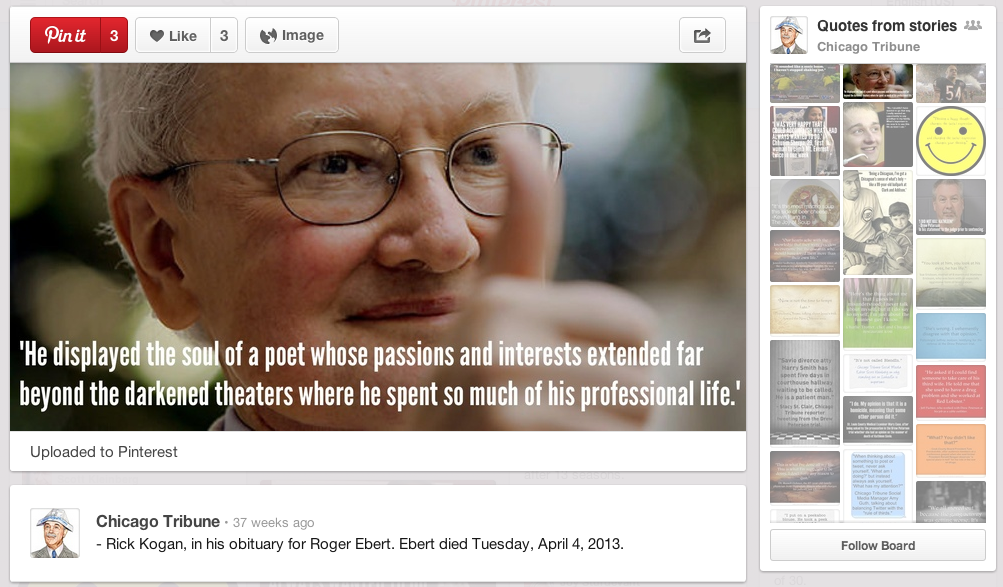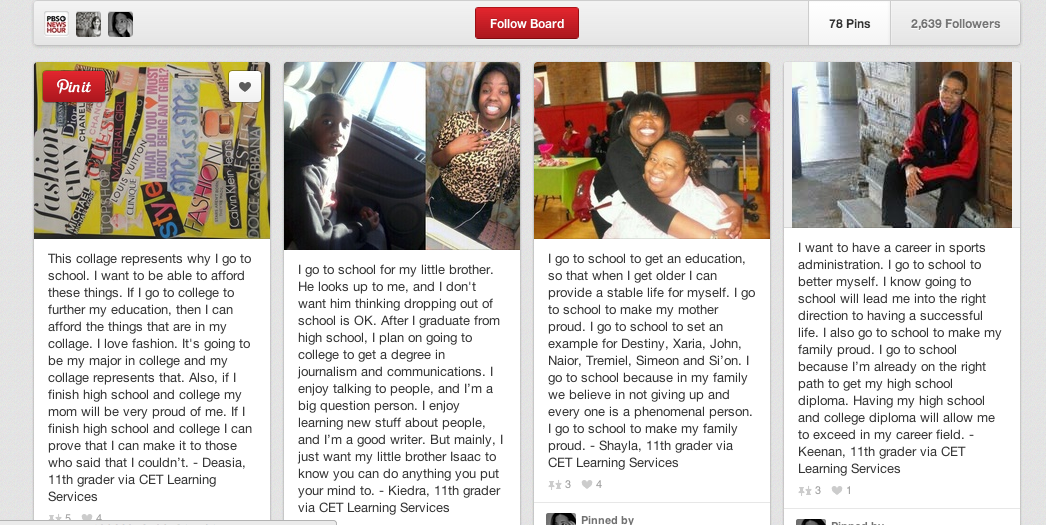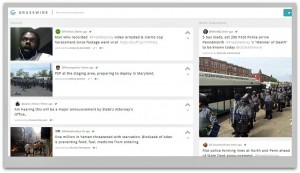
While Twitter and Facebook still tower the social media realm, some news outlets are using Pinterest to retell old stories and tell new ones with a heavily visual flare.
Scott Kleinberg, the social media editor for the Chicago Tribune said he sees Twitter and Facebook like he sees newspapers, and Pinterest like he sees magazines.
“On Pinterest, I take my time,” he said.
For some news outlets, the image-sharing website, which was founded in 2010, provides the chance to step away from traditional content and give it a different flavor.
Colleen Shalby, the social media editor for PBS NewsHour, said Pinterest enables her to show its more than 3,400 followers why news matters on a personal level.
As a part of a project on NewsHour about high school dropouts and graduation rates, it used a Pinterest page to show submitted photos of students who explain why they stay in school.
The Chicago Tribune, which has nearly 3,000 Pinterest followers, includes pictures of events held by the paper and quotes from stories.
Kleinberg said one of the most popular boards is one called Chicago Tribune 100 Years Ago. The section shows some of the news from exactly 100 years before the pinning day.
For example, on Dec. 31, the Pinterest page showcased a quote about attention in Chicago turning to the “the planned parties and revelers in the Loop and keeping everyone in control.”
Kleinberg said people can look at the front page of those papers and contemplate how the news of today compares to 100 years ago.
But news is still only a small reason why Pinterest users visit the social media network. According to a Pew Research study from November 2013, only three percent of Pinterest’s users get news on the website.
The study did not specify how Pinterest is primarily used.
Despite the low concentration of news consumption on Pinterest, Kleinberg and Shalby said they plan to integrate the social media platform more into their respective companies’ social media strategies.
Shalby said she thinks that Pinterest will be more popular in 2014, especially as a place for news, making it worth more investment by news organizations.
Both the Chicago Tribune and PBS NewsHour find that a major share of their Pinterest audience is composed of middle-aged women. But each said they were seeing growth on Pinterest and more younger visitors interacting with their Pinterest pages.
The Chicago Tribune does not have a direct plan for Pinterest but is working to find what sticks, Kleinberg said.
Kleinberg said they’ve found taking a quote from a story and putting it on an aesthetically pleasing background is one way to get people interested in stories.
For example, on a link to Roger Ebert’s obituary, the Pinterest page included his picture and the quote, “He displayed the soul of a poet whose passions and interests extended far beyond the darkened theaters where he spent so much of his professional life.”
Kleinberg said he plans to continue trying to find new ways to engage readers using the technology Pinterest offers.
“That’s stepping on a ledge and doing something different just to see if it works,” Kleinberg said.
Pinterest representatives said that the platform enables news outlets to step beyond displaying just images.
Pinterest has a button called “Pin It” that allows readers to save and share articles to their Pinterest boards. They can then organize that content into categories, such as sports and features.
The benefit of Pinterest for news consumers is the content does not fall off the page and old content can be easily rediscovered, said Malorie Lucich, communications manager for Pinterest, in an email.
But Pinterest is not just being used for news by outlets themselves. Some industry experts are using the platform to organize content to study the media.
The International Center for Media and the Public Agenda used Pinterest during the 2012 presidential election to study whether news outlets show bias to candidates based on pictures.
The project, called PrezPix, used more than 8,000 images, to show how the media pictured presidential candidates. One conclusion was that the media reflected Barack and Michelle Obama as fun and Mitt and Ann Romney as more formal and businesslike.
“Journalism and social media are increasingly trending visual, and until Pinterest, it has been too difficult to evaluate photos, especially in anything approaching real time,” said Susan Moeller, director of the center and a professor at the University of Maryland, in an email.
The center plans to use Pinterest again in an upcoming study about major sports events, Moeller said.
Despite Pinterest’s ability to tell a visual story, some in the industry think the concept of pinning could be better used to share news.
Mark Potts, who worked on the websites for The Washington Post, The Philadelphia Inquirer and most recently, the Lawrence Journal-World, is launching a new board-style website this month that aims to be used for more news-related purposes than Pinterest.
The website, called Newspeg, is using the same kind of pinning technology as Pinterest to crowdsource news information, he said.
Newspeg emphasizes headlines and is more about directing users to stories rather than photographs. Pinterest users, for example, need to click twice access story content — the first click is an enlarged version of the image they see on the platform.
Potts said Newspeg is about finding ways to catalogue news, especially stories, which the site’s content management system makes easier for users.
Newspeg is in an early phase, but Potts said he sees it as something to be used as a supplement with Pinterest.
“Pinterest is really good at what it does but it’s mainly about visuals,” he said.










Leave a Comment